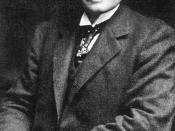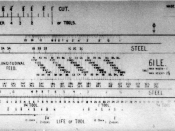1. Introduction
It is fortunately for this generation manager because they have more than century's management theory and thought to retrospect. Although modern management theory dates primarily from the early twentieth century, there was serious thinking and theorizing about managing many years before. Throughout many different contributions of writers and practitioners have resulted different approaches to management, resulting in a kind of management theory jungle and help them to face the challenge of the future.
Despite the inexactness and relative crudity of management theory, the development of thought on management dates back to the days when people first attempted to accomplish goals by working together in groups. To know something of the background of the development of management thought. 'Even limited knowledge can help one appreciate the many opinions, ideas, and scientific underpinnings which preceded the upsurge of management thought may help us avoid rediscovering previously know ideas.' (Harold Koontz, Heinz Weihrich, 1988)
2. Development in management theory
2.1 Management Development History
The history of modern management has been characterized by the swing of a pendulum. 'Trace back the evolution of management theory from the nineteenth century to the present day--basically from Taylorism to Japanization.' (John Sheldrake, 1997) Scientific management developed in the crucible of American industrialization and subsequently spread throughout the industrial and industrializing world.
Taylor proved to be a major instigator of the creation and widespread application of scientific management, although not the first to investigate a theory in this area. However, while Taylor's guidelines for management are perhaps the most widely recognised many contributors to this approach, whose work also shows relevance today. To mention only few below:
'Management as a profession', Mary Parker Follett (1868-1933)
'Classifying the Elements of Work', Frank B. Gilbreth (1868-1924) and Lillian M. Gilbreth (1878-1972)
'The Ideal Bureaucracy', Max Weber (1864-1920),
'Hawthorne experiments', Elton Mayo (1880-1949)
'The Theory of Human Motivation', Abraham H. Maslow (1908-1970)
Many of the theorists strongly disagree with each other. Some of the differences are so radical that they can never be reconciled. An important outcome of this is that, although there might be general agreement from time to time on what constitutes best management practice, the theoretical ingredients will tend to vary. 'Classical management theory is therefore contestable rather than definitive. Although there is a sense of progressive, evolutionary refinement, there is no master narrative to reassure us that the latest theory is necessarily the best.' (John Sheldrake,1997) Management theory did not, of course, arrive fully articulated at the beginning of this century; it already had a considerable history.
3. Classical Approach
3.1 Classical Defined
We always debated whether the management theory is or not useful. First, it is difficult to isolate any particular set of principles or models (classical, behavioural, management science) in "pure" form. Especially translate those principles into practice from the various modifications and efforts. Second, particular principles of management are interpreted differently by various individuals, and the result is often confusion. Third, the major schools of thought espousing management principles house people with differing backgrounds, values, and managerial experience. These differences create some conflict of the disciples and principles of the management theory. The classical writers placed emphasis on the planning of work, the technical requirements of the organisation, principles of management, and assumption of rational and logical behaviour. (Laurie J. Mullins, 2002)
'Classic', in a strict sense, connotes "having recognized worth"; (Michael T. Matteson and John M. Ivancevich, 1981) According to these historical contributions, we believed that have achieved the state of recognition in the field of management.
3.2 Classical Perspective
'The oldest of the "formal" viewpoints of management emerged during the late nineteenth and early twentieth centuries and come ton be know as the classical perspective.' (Pamela S. Lewis, Stephen H. Goodman, Patricia M. Fandt, 1998) The classical perspective had its roots in the management experiences. That was occurring in the rapidly expanding manufacturing organizations that typified U.S and European industrialization. Early contributions were made by management practitioners and theorist from several corners of the world.
The classical perspective consists of three main subfields:
(1) scientific management;
(2) administrative management; and
(3) bureaucracy management. (D.Wren, 1979).
As we will see, scientific management focus on the productivity of the individual worker, administrative management focuses on the functions of management, and bureaucratic management focuses on the overall organizational system. (Pamela S. Lewis, Stephen H. Goodman, Patricia M. Fandt, 1998)
4. Scientific Management
4.1 Scientific Defined
"What is Scientific Management?" by Frederick Taylor (1856-1917), the 'father' of scientific management. Scientific management focuses on the improvement of individual worker productivity. Time and motion studies observe and measure a worker's physical movements in order to determine the best way of performing a task. The expectation in scientific management is that managers will develop standard methods for performing each job, select workers with the appropriate abilities for each job, train workers in stand methods, and support workers by planning their work. These principles are usually summarised as:
? The development of a true science for each person's work;
? The scientific selection, training and development of the workers;
? Co-operation with the workers to ensure work is carried out in the prescribed way;
? The division of work and responsibility between management and the workers.(Laurie. J Mullins, 2002)
4.2 Mental Revolution
In its essence, scientific management also involves a complete mental revolution on the any particular establishment and industry. The mental revolution is not only on the part of workers but also management. It encourages both workers and management to increase the surplus available to them. Scientific management supports harmonious joint efforts and cooperation instead of antagonism and strife. (Michael T. Matteson and John M. Ivancevich, 1981) It complete changes the mental attitude of the both sides and encourage them stop pulling against one another, and instead of achieving to the same direction.
4.3 The drawbacks for the workers:
? it reduced the worker's role to that of a rigid adherence to methods and procedures over which he had no discretion
? it led to increased fragmentation of work due to its emphasis on divisional labour
? it generated an economically based approach to the motivation of employees by enabling pay to geared outputs
? it ruled out any realistic bargaining about wage rates since every job was measured and rated 'scientifically'
In summary, the scientific management technique has recently been employed to increase productivity and efficiency both in private and public services; it has also had the disadvantages of ignoring the human aspects of employment. This led to the creation of boring repetitive jobs with the introduction of systems for tight control and the alienation of shop floor employees from their managers.
5. Administrative Management
5.1 Five Elements of Administrative Management
Administrative management focuses on the managers and the functions they perform. 'This approach to management is most closely identified with Henri Fayol (1841-1925), the 'father' of modern management theory, a French mining engineer, whose major views emerged in the early twentieth century.' (H. Faylo, 1930) He recognized the basic managerial functions is very important for the manager. Depend on his own career; Fayol identified these functions as five elements of the management:
? Planning;
? Organizing;
? Commanding (leading);
? Coordinating; And
? Controlling.
He believed the management process was universally the same whatever the nature of the organisation being managed.
5.2 Fourteen Universal Principles
Fayol also attempted to explain what managers do and how they do it. He argued that there were universal processes and principle that could be applied in managing any type of firm. Under this approach, management was seen as a rational and orderly process and as a continuous process. Fayol established 14 universal principles for managing organisations:
? Division of work;
? Authority and responsibility;
? Discipline;
? Unity of command;
? Unity of direction;
? Subordination of individual to general interest;
? Remuneration;
? Centralization;
? Scalar chain;
? Order;
? Equity;
? Stability of tenure;
? Initiative;
? Esprit de corps.
Throughout many examinations of these functions, he indicates that these principles apply not only to business but also to political, religious, philanthropic, military, and other undertakings.
5.3 Advantages
Fayol was the first person who actually to give a definition of management, which is named 'forecast and plan, to organize, to command, to co-ordinate and to control' today. He indicated much of the basic terminology and concepts, which would be elaborated upon by future researchers such as division of labor, scalar chain, unity of command and centralization
5.4 Disadvantages
? it was basically describing the structure of formal organization
? the absence of attention to issues such as individual verses general interest, remuneration and equity that he saw the employer as paternalistic and also by definition working in the employee's interest
? he does mention the issues relating to the sensitivity of a patients needs, he saw them as an issues in the context of rational organization of structure
Fayol's principles of the administrative management had been improved a lot during the century by the successor. Nevertheless, what contribution he did is not promote them as definite 'law' of management, he gave us the guidance.
6. Bureaucracy management
Bureaucracy management focuses on the overall organizational system and is based upon firm rules, policies, and procedures; a fixed hierarchy; and a clear division of labour. Max Weber (1864-1920), the 'father' of modern organization theory, a German sociologist and historian, is most closely associated with bureaucratic management. M. Weber, General Economic History, trans. F.H. Knight (D. Wren, 1979)
6.1 Characteristics of Bureaucracy
Weber envisioned a system of management that would be based upon impersonal and rational behaviour. Management of this sort is called a bureaucracy, and it has the following characteristics:
1) Division of labour;
2) Hierarchy of authority;
3) Rules and procedures;
4) Impersonality;
5) Employee selection and promotion; (M. Weber,1947)
6.2 Three Styles Authorities
Weber also believed there were three different types of authority:
1) Charismatic authority
2) Traditional authority
3) Rational-legal authority. (Mike Jackson, 2000)
In Weber's view it was 'legal authority' that characterized the modern organization and was associated with the establishment of bureaucracy.
Weber identified the growing centrality of expert, technical knowledge in modern, industrial societies and recognized the significance of rational, administrative systems in complex organizations. 'Certainly his notion of rational bureaucracy is without doubt the single most important statement on the subject in the social sciences' (Michael T. Matteson and John M. Ivancevich, 1981 )
6.3 Advantages
The fact of that appointment, promotion and authority were dependent on technical competence and reinforced by written rules and procedures of promoting those most able to manage rather than those favoured to manage. We take a lot of this for granted in the UK today. Anything else regarded as nepotism and corruption
? the adoption of bureaucratic type of management systems allow organizations to grow into large complex organized systems that are geared towards formalized explicit goals
? it cannot be stated strongly enough that the Weber theory has the advantage of being used as a gold standard on which to compare and develop other modern theories
6.4 Disadvantages
Subsequent analyses by other researchers have identified many disadvantages:
?tendency for organizations to become procedure- dominated rather than goal dominated
? too heavy formalized organizational roles to suppress initiative and flexibility of the job holders
? rigid behavior by senior managers can lead to standardized services that neglect the needs of the client
? too emphasis procedures and rules will demotivate the subordinates that work in the organizations
Of course, Weber's 'idea-type' bureaucracy theory has many shortcomings with which compared the modern organizations. It might be regarded as inefficiency rather than efficiency. It also be though cannot be achieving in the practice but in theory. What it needs to be remained is that this basic bureaucratic module still exists in all over the world and acts an important role throughout the modern organization.
7. Relevance of classical approach
After the economic crisis of the South Asia in 1997, most of the south Asia countries met the difficulties and sank into the confusing of how to reorganize the organizational structure. 'If we understand the managerial philosophies of the past and present, we will be better equipped to be successful managers in the future.' (Pamela S. Lewis, Stephen H. Goodman, Patricia M. Fandt, 1998)
8. Conclusion
The classical thinkers of the late nineteenth and early twentieth centuries made many valuable contributions to the theory and practice of management. However, their theories did not always achieve desirable results in the situations that were developing in the early twentieth century. 'Changes were occurring in these fields that gave rise to new perspectives on management. ' (Pamela S. Lewis, Stephen H. Goodman, Patricia M. Fandt, 1998)
'The concept of management and the basic management functions are not new phenomena. Throughout the history record, activities have been conducted to the management functions.' (Pamela S. Lewis, Stephen H. Goodman, Patricia M. Fandt, 1998) The classical management theory not only important in the past, but also it continues to be important in present, both in the erection of modern-day edifices. The monuments it left in which is the conduct of business and industry around the globe. Management will continue to be important as long as humans survive on earth.
Therefore, according to the above analysis, it is obviously shows that the classical management theories not only have the value today, but also the development guide-line of the direction in the future.
References
Harold Koontz, Heinz Weihrich, Management a Global Perspective, McGraw-Hill International Editions, 9 ed, 1988, p30
John Sheldrake, Management Theory from Taylorism to Japannization, An International Thomson Publishing Company, 1997, p 209
John Sheldrake, Management Theory from Taylorism to Japannization, An International Thomson Publishing Company. 1997, p9
Laurie J. Mullins, Management Organisational Behaviour, Prentice Hall, 6 ed, 2000
Michael T. Matteson and John M. Ivancevich, Management Classics, 2 ed, Goodyear Publishing Co., Inc, California, 1981, p2
Pamela S. Lewis, Stephen H. Goodman, Patricia M. Fandt, "Management Challenges in the 21 century, South-Western College Publishing", 2, 1998, p47
D. Wren, Evolution of management Thought, New York: Wiley, 2d ed.1979, p40
Pamela S. Lewis, Stephen H. Goodman, Patricia M. Fandt, Management Challenges in the 21st century, South-Western College Publishing, 1998, p47
Laurie. J Mullins, Management and Organisational Behaviour, 2002, p55
Michael T. Matteson and John M. Ivancevich, Management Classics, 2 ed, Goodyear Publishing Co., Inc, California, 1981, p6
H. Faylo, Industrial and general Administration, New York: Sir Isaac, Pitman and Sons, 1930
D. Wren, Evolution of Management Thought, New York: Wiley, 2d ed.1979, p46
Michael T. Matteson and John M. Ivancevich, Management Classics, 2 ed, Goodyear Publishing Co., Inc, California, 1981, p53
Pamela S. Lewis, Stephen H. Goodman, Patricia M. Fandt, Management Challenges in the 21st century, South-Western College Publishing, 1998, p51
Mike Jackson, DMT Guide Book, University of Hull, 2000, p22
Michael T. Matteson and John M. Ivancevich, Management Classics, 2 ed, Goodyear Publishing Co., Inc, California, 1981, p56
Pamela S. Lewis, Stephen H. Goodman, Patricia M. Fandt, Management Challenges in the 21st century, South-Western College Publishing, 1998, p53
Pamela S. Lewis, Stephen H. Goodman, Patricia M. Fandt, Management Challenges in the 21st century, South-Western College Publishing, 1998, 41
Pamela S. Lewis, Stephen H. Goodman, Patricia M. Fandt, Management Challenges in the 21st century, South-Western College Publishing, 1998, 41



Could have been better with more attention to detail
Although the thought behind this essay was pretty good, I found the poor grammar to be quite distracting as I tried to work out what the author was actually trying to say. Also, the conclusion was weak and disappointing after such a good build-up.
0 out of 0 people found this comment useful.